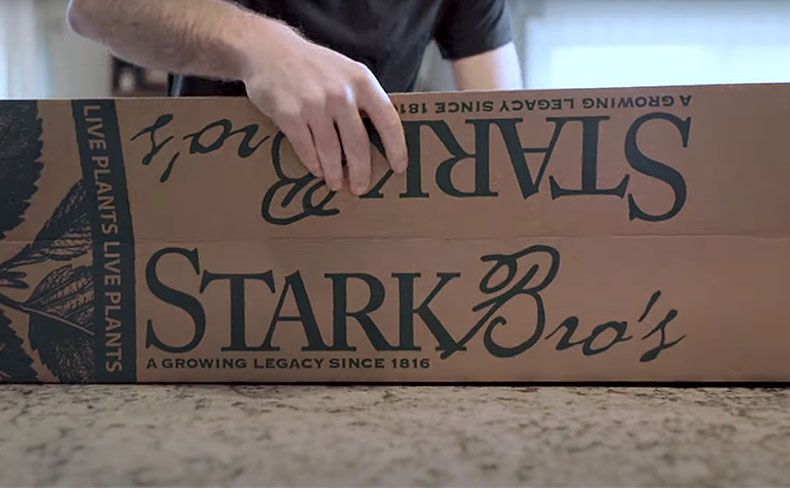How to Plant Bare-Root Raspberry Plants
Growing your own raspberries can be one of the easiest and most fruitful garden ventures. Read our step-by-step guide to planting bare-root raspberries.


Raspberry plants are as simple to grow as garden veggies, like tomatoes and peppers, but they go dormant in the fall and winter and come back each spring to bloom and fruit during the summer and fall! At Stark Bro's, we offer a selection of bare-root raspberry plants including red, black, purple, and gold varieties.
Our bare-root raspberry plants will not arrive with any soil when we ship them to you. The plants will be in bundles of 3, which consist of dormant canes and healthy root systems. They will be packaged with damp strips of paper to keep the roots from drying out*. As much as they appear to be lifeless, they are actually dormant, which is a necessary resting state that helps with future fruit production. As a bonus, dormant plants experience less transplant shock, so their chances of survival are improved!
*If you notice that the paper is not directly touching the root system when your raspberry plants arrive, don't worry! The environment of the overall packaging will keep the roots from drying out even if they are not in direct contact with the paper.
Planting Bare-Root Raspberry Plants
There aren't any tricks to planting bare-root raspberry plants, so it's an easy process to follow.
Here's what you need:
- Bare-root raspberry plants
- Hole-digging tool (hand trowel, shovel, etc.)
- Pruners
- Bucket and water for soaking
Preparation
- Remove the bare-root raspberry plants from the packaging and separate the plants from the bundle. Be careful of thorns if you are planting a thorned variety! Prune any individual damaged roots before planting. Allow just the roots to soak in a bucket of water for up to two hours before planting. Many gardeners like to allow their bare-root raspberry plants' roots to soak as they prepare the planting holes.
- Choose a well-drained planting site with full sun (6-8 hours daily) and make sure the area is free of weeds. You may want to plan ahead and build a small trellis for your raspberry plants so that, once they're heavy with fruit, they will have the support they need to keep from bending over or breaking. You can find instructions on constructing a raspberry trellis from your local University Extension (UMaine has a good example) or you can use a large, sturdy "tomato cage" around each plant. It's up to you!
- It is always ideal to test the soil of your planting site prior to planting. Soil tests help you to be sure that the pH is ideal for your new plants (6.0-6.8 for raspberries) and to be sure other necessary minerals and nutrients are available to nourish your plants. For a boost during the growing season, when the raspberry plants begin to leaf out, you can apply a fertilizer like Stark® Raspberry Food.
Another nutritious option is compost. This gardening favorite, which helps add nutrients to the soil, can also double as a mulch to keep weeds down and insulate roots during the winter!

Planting
- Using a hand trowel or a shovel, dig your planting holes. Each bare-root raspberry plant will need its own planting hole. The width and depth of the planting holes should be enough to accommodate each plant's current root system, while allowing some space for the roots to spread out. Each planting hole should be about 3 feet apart. This allows each mature plant to have its own space to grow and set fruit.
- When positioned in the hole, back-fill the soil in over and around the raspberry plant's roots, so that the topmost root has about an inch or two of soil covering it. Tamp the soil down with your hands to remove any air pockets that may have formed around the roots. Water thoroughly, reusing the water from the root-soaking bucket or from a hose to give the roots their first drink in their new home.
- This part is very important: After planting, be sure to prune the bare-root canes back to about 2 inches above the ground. Many growers hesitate or skip this step, but it is crucial in encouraging the roots to send up new growth during the growing season. It is in the nature of raspberry plants to send up new growth as suckers or basal shoots from below the ground. This means the canes that you plant may not be where to look for life or new growth in the spring. In addition to buds on the cane, you should see new sprouts emerge up through the ground from the root system.
Following these steps will help you get your new bare-root raspberry plants off to a solid start. After they become established, you will enjoy fresh, easy-to-pick raspberries year after year.
Bare-Root Raspberry Breaking Dormancy
The images below depict what new growth will look like in the growing season, after planting and properly pruning bare-root raspberry plants:
And remember, if your raspberry plants arrive and you are not able to plant them immediately, you can delay planting by following the steps mentioned in our article:



